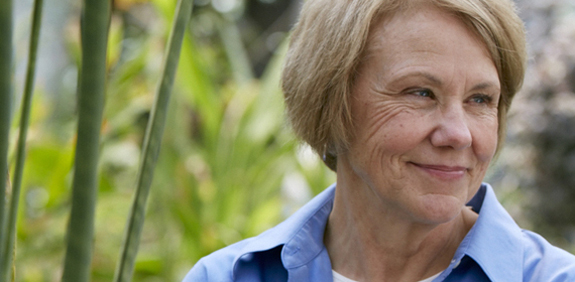
Mary Butkus/WUSTL
Gary Wihl, dean of the faculty of Arts & Sciences, presents evolutionary biologist David C. Queller with the medallion that symbolizes his installation as the Spencer T. Olin Professor of Biology in Arts & Sciences.
Evolutionary biologist David C. Queller, PhD, was
installed Oct. 16 as the Spencer T. Olin Professor of Biology in Arts
& Sciences in a ceremony in Holmes Lounge.
“We’re here to celebrate David Queller and officially bestow the highest award that a university can bestow on a faculty member, a named professorship,” Gary Wihl, PhD, dean of the faculty of Arts & Sciences, said. He said he was proud to have been part of the effort to bring Queller and his colleague and spouse Joan Strassmann to Washington University. “It was a great triumph for the biology department and Arts & Sciences that we were able to recruit them.”
Queller was introduced by Barbara Schaal, PhD, the Mary-Dell Chilton Distinguished Professor of Biology. “He is one of the country’s foremost evolutionary biologists, and one of the leading scholars investigating the emergence of cooperative behavior in social organisms,” she said.
Queller graduated from the University of Illinois in 1976 with bachelor’s degree in the history and philosophy of science. He earned a PhD in biology in 1982 from the University of Michigan. He was a faculty member at Rice University in Houston from 1989 to 2011, becoming the Harry C. and Olga K. Wiess Professor in Natural Sciences.
“Together Queller and Strassmann are a remarkable couple and research team,” Schaal said, “and they’ve brought a very lively intellectual dialog to the biology department.”
Their work has led to a long array of publications in the best journals of the field. “There is an astounding series of papers in Nature that talk about their work both with social insects and now with the newer system Dictyostelium,” Schaal said.
Their research with the social amoeba Dictyostelium discoideum is shedding light on the earliest stages of the evolution of cooperation, she said.
Among other honors, Queller won the American Society of Naturalists Young Investigator Award in 1985, and a John Simon Guggenheim Memorial Fellowship in 1988. He is an elected member of American Association for the Advancement of Science and an elected Fellow of the American Academy of Arts & Sciences.
Following the formal installation and the presentation of the professorship medallion, Queller spoke on the evolution of cooperation. “Life comes organized in chunks we call organisms,” he said, “and the organism is the main dividing line in biology. An organism’s interactions with life outside itself are at best indifferent and often hostile. On the other hand, inside the border of the organism, everything is happy and cooperative.”
Queller then made two “forays” that bend the limits of this idea of the organism. “Some people think that social insect colonies, at least the most advanced ones, are themselves organisms, distinguished by the willingness of individuals to sacrifice themselves for the good of the colony,” he said.
The theory of kin selection often predicts what will happen when conflicts arise: that cooperation is more likely among close relatives than more distant ones. Or as J. B. S. Haldane, one of the founders of kin selection, jestingly said, he would jump in a river to save two brothers or eight cousins. Degrees of kinship, for example, predict that stingless bees will allow their sisters to lay eggs unmolested but that honeybees will eat eggs if their sisters lay them.
“Social insects are a great example of the evolution of cooperation among organisms,” Queller said, “but I would suggest that they might also be a great example of the opposite: the lack of cooperation within an individual body.” The key mechanism here is imprinting, a process by which the parents mark the genes they give to their offspring so that a gene from the father (a patrigene) is distinguishable from a gene from the mother (a matrigene).
“The theory that patrigenes and matrigenes butt heads within organisms has not been well tested, Queller said, but social insects provide an ideal model system to test it, because they’re surrounded by relatives their entire lives and they interact in many different ways, so there are many opportunities for imprinting conflict.
“Social insects have always been a paradigm for cooperation above the level of the individual, the colonies,” he said, and “we think they’re going to be one of the coolest paradigm systems for studying conflict with the individual between the matrigenes and the patrigenes.”
About Ann W. and Spencer T. Olin
The professorship Queller now holds was established in 1996 with a bequest from Spencer T. Olin, a longtime member of the WUSTL Board of Trustees.
Spencer Olin graduated in 1921 from Cornell University and began his career working in the family business, Western Cartridge Company in East Alton, Ill. With several mergers and acquisitions the company grew throughout the 21st century, diversifying into chemicals, pharmaceuticals, paper products, plastics, mining, home construction and automotive specialties. In the 1950s the Olin Corporation had 35,000 employees working in 46 domestic and 17 overseas plants.
The Ann Whitney Olin Women’s Building is named for Olin’s wife, Ann Whitney Olin. Spencer and Ann Olin also directed their generosity toward the Mr. and Mrs. Spencer T. Olin Fellowship program for Women in Graduate Study, the Olin conference in women in higher education and the professions, and the Olin residence hall at the School of Medicine.
The Olins endowed seven professorships, including two in biology and others in mathematics, engineering and medicine.
Ann Olin died in 1976; Spencer Olin in 1995.





































